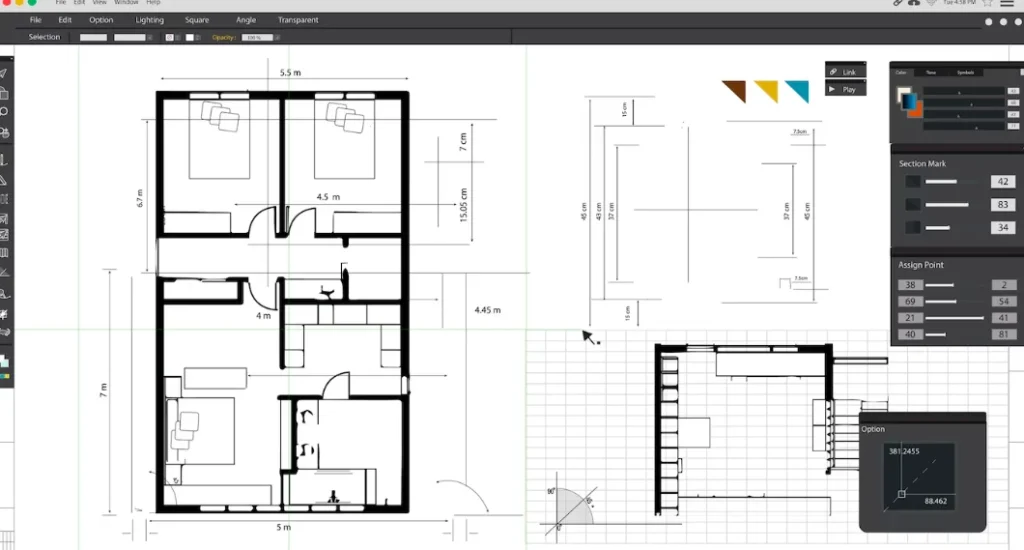When it comes to designing a space, whether it’s a home, office, or commercial building, selecting the right floor plan is crucial. A good floor plan allows for a seamless flow between spaces, optimizes the available square footage, and ensures that your design vision comes to life. The process of creating or selecting a floor plan can be daunting, especially when there are numerous tools available to help you do so. This article explores key factors to consider when choosing the best floor plan creator for your specific design needs, helping you find the perfect tool for your project.
1. Determine the Type of Space You Are Designing
The first step in choosing a floor plan creator is to clearly define the type of space you’re working with. Different design needs may require specific features, and understanding this will guide your selection process. Residential, commercial, and industrial spaces all have unique considerations, such as layout, flow, and functionality. A tool that works well for designing a small apartment may not be as effective for creating a large office complex.
For residential designs, you might need features that allow for detailed room measurements, furniture placement, and specific architectural elements such as windows and doors. On the other hand, commercial spaces might require tools that cater to different room types, customer flow, and zoning regulations. It’s important to choose a floor plan creator that accommodates the type of space you are working with.
2. User-Friendliness and Interface Design
The ease of use of the software is another essential factor to consider. Whether you are a beginner or an experienced designer, a floor plan creator should be intuitive and accessible. If you are unfamiliar with design software, a user-friendly interface will make the process much smoother. Some tools provide drag-and-drop functionality, where you can simply move elements around the screen to adjust the layout. Others may have more complex features suited for professional designers who are comfortable with intricate software.
Look for a tool that offers a balance between simplicity and advanced features. Ideally, it should provide enough versatility to accommodate various design needs without overwhelming you with too many options. Some creators also come with pre-built templates that can serve as a starting point, saving time and effort in the planning process.
3. Customization and Flexibility
Flexibility is key when choosing a floor plan creator, as every design project is unique. The software should allow you to make adjustments to room sizes, walls, and layout configurations with ease. If you are designing a home, for example, you may want to add or remove walls, change the orientation of certain rooms, or experiment with different placements of doors and windows. A good floor plan creator should give you the freedom to make these adjustments without limitations.
Furthermore, the ability to customize the design with furniture, decor, and other elements can help bring your vision to life. Some floor plan creators allow for 3D visualization, enabling you to get a more accurate sense of how the space will feel once it is constructed. The more flexibility a tool provides, the easier it will be to adapt the floor plan to your specific needs.
4. Compatibility with Other Software
Many design projects require collaboration with other professionals, such as architects, interior designers, and builders. Choosing a floor plan creator that is compatible with other design software can help facilitate this collaboration. For example, if you are working with an architect, the floor plan creator should allow you to export the design into a format that can be opened in CAD software. Similarly, if you plan on adding 3D renderings or virtual tours, ensure the tool supports integration with rendering programs.
If you plan to integrate your design with a project management tool, such as for construction planning or resource management, check that the floor plan creator can sync with these systems. The more compatible the software is with other programs, the smoother the overall workflow will be.
5. Pricing and Budget Considerations
While some floor plan creators offer free versions, many come with a range of pricing options depending on the features and capabilities you need. Before selecting a floor plan creator, it’s important to evaluate your budget and determine whether the tool fits within it. Some free options might be sufficient for basic designs, while others may require a subscription or one-time payment for access to advanced features.
It’s essential to assess what features are included in each pricing tier. For instance, some premium options may offer unlimited access to templates, enhanced customization, and advanced 3D visualization. Others may have additional collaboration features that allow multiple users to work on the same project simultaneously. Consider your needs carefully and choose a plan that offers the best value for your budget.
6. 3D Visualization and Rendering
One of the most significant advancements in floor plan design software is the ability to create 3D renderings and visualizations of your space. Being able to see your floor plan in three dimensions adds an entirely new layer of understanding to your design. It can help you visualize how the layout will look in real life, giving you a clearer idea of proportions and how the space will function.
Some tools allow you to walk through the design in virtual reality or provide photorealistic renderings that help you see how natural light interacts with the space or how different materials and textures will appear. 3D visualization can also help you make decisions about furniture placement and spatial relationships, which is especially useful when designing a complex layout. For more detailed and realistic results, look for a floor plan creator that supports high-quality 3D rendering.
7. Support and Resources
When using a floor plan creator, it’s helpful to have access to comprehensive support and resources. These might include user guides, video tutorials, FAQs, and customer service teams who can assist with technical issues or questions. Some tools also provide design inspiration and templates that can help you get started. If you’re new to floor planning, a robust library of resources can be invaluable in learning how to use the tool effectively and efficiently.
A well-established software provider should also offer reliable customer support channels, including phone, email, or live chat, should you encounter any difficulties while working on your design. Strong customer support is especially important if you are working on tight deadlines or need immediate assistance.
8. Reviews and User Feedback
Before committing to any floor plan creator, take the time to research user reviews and feedback. Many online communities, forums, and review websites offer insights into the strengths and weaknesses of various design tools. Look for reviews from users who have similar design needs and goals, as their experiences will give you a clearer idea of how the tool functions in real-world scenarios.
Pay attention to common issues raised by users, such as software bugs, lack of features, or poor customer support. However, remember that no tool is perfect, and consider both positive and negative reviews to form a balanced opinion. User feedback can help you determine if the floor plan creator aligns with your expectations and project requirements.
9. Scalability for Future Projects
Finally, consider the scalability of the floor plan creator for future projects. Even if you only have one design project at the moment, selecting a tool that can accommodate larger and more complex projects in the future can save you from having to switch to a new tool later. Scalability is especially important if you anticipate growing your design skills or expanding your work scope.
Choose a floor plan creator that will allow you to take on more intricate designs as your needs evolve. Many software options offer different tiers of service that can accommodate increasingly complex projects, whether you’re designing larger homes, commercial spaces, or multi-building developments.
Conclusion
Choosing the right floor plan creator for your design needs requires careful consideration of your project type, desired features, user experience, and budget. By evaluating the factors discussed above, you can make an informed decision that enhances your design process. The right tool will not only help you visualize your ideas more clearly but will also support collaboration, customization, and future growth. With the right floor plan creator, you can bring your designs to life and create spaces that are both functional and aesthetically pleasing.







